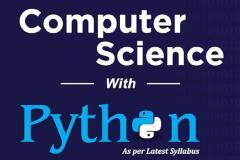ICSE Physics Class 10 Public Exam Prep course. Weekly 2 classes.
Consise Concepts Introduction with Questions and Solution Disccussions
Sample Question papers and soluion discussion. The couse will Cover following Topics
- Force, Work, Power and Energy
(i) Turning forces concept; moment of a force; forces in equilibrium; centre of gravity; [discussions using simple examples and simple numerical problems].
Elementary introduction of translational and rotational motions; moment
(turning effect) of a force, also called torque and its cgs and SI units; common examples - door, steering wheel, bicycle pedal, etc.; clockwise and anti-clockwise moments; conditions for a body to be in equilibrium ( translational and rotational); principle of moment and its verification using a metre rule suspended by two spring balances with slotted weights hanging from it; simple numerical problems; Centre of gravity (qualitative only) with examples of some regular bodies and irregular lamina.
(ii) Work, energy, power and their relation with force.
Definition of work. W=FScosθ; special cases of θ = 00, 900. W= mgh. Definition of energy, energy as work done. Various units of work and energy and their relation with SI units. [erg, calorie, kW h and eV]. Definition of Power, P=W/t; SI and cgs units; other units, kilowatt (kW), megawatt (MW) and gigawatt (GW); and horsepower (1hp=746W) [Simple numerical problems on work, power and energy].
(iii) Different types of energy (e.g., chemical energy, Mechanical energy, heat energy, electrical energy, nuclear energy, sound energy, light energy).
Mechanical energy: potential energy U = mgh (derivation included) gravitational PE, examples; kinetic energy K= ½ mv2 (derivation included); forms of kinetic energy: translational, rotational and vibrational - only simple examples. [Numerical problems on K and U only in case of translational motion]; qualitative discussions of electrical, chemical, heat, nuclear, light and sound energy, conversion from one form to another; common examples.
(iv) Machines as force multipliers; load, effort, mechanical advantage, velocity ratio and efficiency; pulley systems showing the utility of each type of machine.
Functions and uses of simple machines: Terms- effort E, load L, mechanical advantage MA = L/E, velocity ratio VR = VE/VL = dE / dL, input (Wi), output (Wo), efficiency (η), relation between η and MA, VR (derivation included); for all practical machines η <1; MA < VR.
Pulley system: single fixed, single movable, block and tackle; MA, VR and η in each case. [Pulleys using single tackle]
(v) Principle of Conservation of energy.
Statement of the principle of conservation of energy; theoretical verification that U + K = constant for a freely falling body. Application of this law to simple pendulum (qualitative only); [simple numerical problems].
- Light
(i) Refraction of light through a glass block and a triangular prism - qualitative treatment of simple applications such as real and apparent depth of objects in water and apparent bending of sticks in water. Applications of refraction of light.
Partial reflection and refraction due to change in medium. Laws of refraction; the effect on speed (V), wavelength (λ) and frequency (f) due to refraction of light; conditions for a light ray to pass undeviated. Values of speed of light (c) in vacuum, air, water and glass; refractive index μ = c/V, V = fλ. Values of μ for common substances such as water, glass and diamond; experimental verification; refraction through glass block; lateral displacement; multiple images in thick glass plate / mirror; [Diagrammatic representation not to be tested]; refraction through a glass prism, simple applications: real and apparent depth of objects in water; apparent bending of a stick under water. (Simple numerical problems and approximate ray diagrams required).
(ii) Total internal reflection: Critical angle; examples in triangular glass prisms; comparison with reflection from a plane mirror (qualitative only). Applications of total internal reflection.
Transmission of light from a denser medium (glass/water) to a rarer medium (air) at different angles of incidence; critical angle (C) μ = 1/sin C. Essential conditions for total internal reflection. Total internal reflection in a triangular glass prism; ray diagram, different cases - angles of prism (60º,60º,60º), (60º,30º,90º), (45º,45º,90º); use of right-angle prism to obtain δ = 90º and 180º (ray diagram); comparison of total internal reflection from a prism and reflection from a plane mirror.
(iii) Lenses (converging and diverging) including characteristics of the images formed (using ray diagrams only); magnifying glass; location of images using ray diagrams and thereby determining magnification.
Types of lenses (converging and diverging), convex and concave, action of a lens as a set of prisms; technical terms; centre of curvature, radii of curvature, principal axis, foci, focal plane and focal length; detailed study of refraction of light in spherical lenses through ray diagrams; formation of images - principal rays or construction rays; location of images from ray diagram for various positions of a small linear object on the principal axis; characteristics of images. Sign convention and direct numerical problems using the lens formula are included (derivation of formula not required).
Scale drawing or graphical representation of ray diagrams not required.
Power of a lens (concave and convex) – [simple direct numerical problems]: magnifying glass or simple microscope: location of image and magnification from ray diagram only [formula and numerical problems not included]. Applications of lenses.
(iv) Using a triangular prism to produce a visible spectrum from white light; Electromagnetic spectrum.
Deviation produced by a triangular prism; dependence on colour (wavelength) of light; dispersion and spectrum; electromagnetic spectrum: broad classification (names only arranged in order of increasing wavelength); properties common to all electromagnetic radiations; properties and uses of infrared and ultraviolet radiation.
- Sound
(i) Reflection of Sound Waves; echoes: their use; simple numerical problems on echoes.
Production of echoes, condition for formation of echoes; simple numerical problems; use of echoes by bats, dolphins, fishermen, medical field. SONAR.
(ii) Natural vibrations, Damped vibrations, Forced vibrations and Resonance - a special case of forced vibrations.
Meaning and simple applications of natural, damped, forced vibrations and resonance.
(iii) Loudness, pitch and quality of sound:
Definitions of the characteristics of sound and factors affecting them only.
- Electricity and Magnetism
(i) Ohm’s Law; concepts of emf, potential difference, resistance; resistances in series and parallel, internal resistance.
Concepts of pd (V), current (I), resistance (R) and charge (Q). Ohm's law: statement, V=IR; SI units; experimental verification; graph of V vs I and resistance from slope; ohmic and non-ohmic resistors, factors affecting resistance (including specific resistance) and internal resistance; super conductors, electromotive force (emf); combination of resistances in series and parallel. Simple numerical problems using the above relations. [Simple network of resistors including not more than four external resistors. Internal resistance may be included].
(ii) Electrical power and energy.
Electrical energy; examples of heater, motor, lamp, loudspeaker, etc. Electrical power; measurement of electrical energy, W = QV = VIt from the definition of pd. Combining with ohm’s law W = VIt = I2 Rt = (V2/R)t and electrical power P = (W/t) = VI = I2R = V2/R. Units: SI and commercial; Power rating of common appliances, household consumption of electric energy; calculation of total energy consumed by electrical appliances; W = Pt (kilowatt × hour = kW h), [simple numerical problems].
(iii) Household circuits – main circuit; switches; fuses; earthing; safety precautions; three-pin plugs; colour coding of wires.
House wiring (ring system – no diagrammatic representation), power distribution; main circuit (3 wires-live, neutral, earth) with fuse / MCB, main switch and its advantages - circuit diagram, need for earthing, fuse, 3-pin plug and socket; Conventional location of live, neutral and earth points in 3 pin plugs and sockets. Safety precautions, colour coding of wires.
(iv) Magnetic effect of a current (principles only, statement of laws not required); electromagnetic induction (elementary).
Oersted’s experiment on the magnetic effect of electric current; magnetic field (B) and field lines due to current in a straight wire (qualitative only); Right Hand Thumb Rule – magnetic field due to a current in a loop; Electromagnets: their uses; comparisons with a permanent magnet; conductor carrying current in a magnetic field experiences a force, Fleming’s Left Hand Rule, and its understanding, Simple introduction to electromagnetic induction; a magnet moved along the axis of a solenoid induces current, Fleming’s Right Hand Rule and its application in understanding the direction of current in a coil and Lenz’s law. Comparison of AC and DC.
- Heat
(i) Calorimetry: meaning, specific heat capacity; principle of method of mixtures; Numerical Problems on specific heat capacity using heat loss and gain and the method of mixtures.
Heat and its units (calorie, joule), temperature and its units (oC,, K); thermal (heat) capacity C' = Q/êT... (SI unit of C'): Specific heat Capacity C = Q/mêT (SI unit of C) Mutual relation between Heat Capacity and Specific Heat capacity, values of C for some common substances (ice, water and copper). Principle of method of mixtures including mathematical statement. Natural phenomenon involving specific heat. Consequences of high specific heat of water. [Simple numerical problems].
(ii) Latent heat; loss and gain of heat involving change of state for fusion only.
Change of phase (state); heating curve for water; latent heat; specific latent heat of fusion (SI unit). Simple numerical problems. Common physical phenomena involving latent heat of fusion.
- Modern Physics
Radioactivity and changes in the nucleus; background radiation and safety precautions.
Brief introduction (qualitative only) of the nucleus, nuclear structure, atomic number (Z), mass number (A). Radioactivity as spontaneous disintegration. α, β and γ- their nature and properties; changes within the nucleus. One example each of α and β decay with equations showing changes in Z and A.
Uses of radioactivity - radio isotopes. Harmful effects. Safety precautions. Background radiation.
Radiation: X-rays; radioactive fallout from nuclear plants and other sources.
Nuclear Energy: working on safe disposal of waste. Safety measures to be strictly reinforced.








